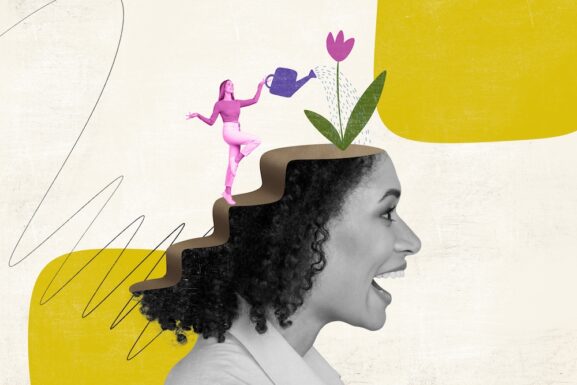Are Psychedelic Diagnoses Freeing Us? Or Caging Us?
About eighteen months ago, I had an experience that changed how I look at myself.
I ate a THC edible and listened to an interview with Gabor Maté, the Canadian physician and trauma-centered commentator, on Russell Brand’s podcast (surely the kind of podcast that people in the psychedelic culture are likely to select). Enthused by Maté’s sleepy charisma, I became convinced I had ADHD and trauma and everything clicked into place.
That explains why I struggled to stay on a Google doc and not click away to a Reddit thread. This would explain why I tuned out so often when people were speaking to me, or procrastinated for months in paying bills and seeing doctors.
For the next several weeks, I read voraciously on ADHD. I compulsively checked lists online of symptom criteria. Yet I found myself being gradually nudged into being someone with ADHD. The labeling itself had affected my ‘symptoms’.
My attention span got worse. The discomfort deepened. My procrastination reached almost comical degrees of severity: spending an entire day high on seven cups of coffee (‘medication’) only to write a single paragraph for an assignment. I felt helpless over a sickness I had—and possibly would have to live with—and began using nicotine as a further stimulant ‘medication’.
My decline made me wonder: why aren’t I healing my ADHD? What is ADHD? What if I’m thinking about these diagnoses all wrong?

Some Amazonian tribes have words for ‘sadness’ but not ‘depression’.
Why These Diagnostic Labels Matter
It’s often said that psychedelics can treat a range of conditions, including depression, anxiety, PTSD and addiction. It is often taken for granted that such states of mind and body should be taken as conditions: that is, as disorders best-understood in medical terms of diagnoses, medications and interactions with doctors.
Diagnosing myself with trauma and ADHD felt like a way to understand myself. Since then, I’ve had to re-think everything. And question whether podcasts and medical labels are the best ways to find explanations.
In this article, we’ll discuss the pros and cons of the ‘medical model’ and the practice of diagnosis. We’ll cover the ways that diagnoses shape our self-understanding and journeying with psychedelics, together with the medical model’s place in broader society.
What is the Medical Model in Psychology?
The ‘medical model’ has been enormously influential. While it lacks a formalized definition, the medical model is taken broadly to frame psychological problems as shaped mainly by biological factors like brain chemistry and genetics.
The medical model was advanced in the 1970s to affirm psychiatry’s place as a distinct area of medicine. Together with patient groups and pharmaceutical companies, psychiatrists advocated the medical model as a route to de-stigmatizing psychological problems. This is because ‘mental health’ complaints were presented as illnesses ‘like any other,’ stemming largely from dysfunctions in the brain and nervous system. Many patients were told that their depression, for instance, was the result of a chemical imbalance of serotonin, which required the prescription of Selective Serotonin Reuptake Inhibitors (SSRIs) like Prozac and Zoloft.
RELATED: Ketamine Therapy vs. Antidepressants: What Are The Pros And Cons Of Each?
George Engel’s biopsychosocial model is conventionally held as the governing thought system behind psychiatry. This understands mental disorders as shaped by psychological and social factors as well as biological ones. Influenced by pharmaceutical companies, research since the 1970s has focused overwhelmingly on biological factors, however. Psychiatric outcomes have largely stagnated or gotten worse in the years since—especially relative to other areas of medicine like cancer treatment. These outcomes have motivated the renaissance of psychedelic therapies, as people seek new treatments.
Diagnosis and the Medical Model
The guide for psychologists and psychiatrists issuing diagnoses is the Diagnostic and Statistical Manual (DSM-5), which lists symptoms of recognised mental disorders. If you were to pursue diagnosis, your experience would be recorded using a patient interview and questionnaire and compared against DSM-5 checklists to see which diagnosis best fits. You will likely be subject to physical tests to ensure there is not something else going on that’s creating your problems.
FIND A CAREER IN PSYCHEDELICS: Psychedelic-Assisted Therapy Certifications and Training

What is the Place of the Medical Model for Psychedelic Therapies?
Psychedelic-assisted therapies have a complex relationship with the medical model. Because the experience they induce is often so subjectively meaningful, psychedelics reaffirm the role of life events, spirituality and narratives in influencing our states of mind.
As the neuroscientist Dr. Eduardo Schenberg argued in an influential paper, psychedelic therapies therefore fit better with the aspirations of the biopsychosocial model, as opposed to thinking about mental problems as simply issues of biology. And while psychedelics are chemico-biological agents, the role of neurobiology in mediating psychedelics’ therapeutic benefits may have still been overstated. For instance, the fundamental mechanism is often assumed to be something going on in the brain: rising quantities of particular neurotransmitters or measures of neuroplasticity.
Yet these changes may be more correlational than causal compared to the psychosocial effects of a powerful spiritual experience, together with therapy and the ways our lives change in turn. This tendency to overstate the brain is called neurocentrism, and it has been identified as a problem with the medical model.
Psychedelics work on the brain. Is that all they do?
Psychedelics are also tied to diagnostic practice. In the case of ketamine, the nasal spray Spravato is earmarked only for those diagnosed with ‘treatment-resistant depression’: a depression that hasn’t been lifted by the use of two previous antidepressants. Spravato is the only ketamine treatment approved by the FDA for a psychiatric condition. And while most intravenous ketamine is not covered by insurance, gaining coverage for psychiatric complaints in general requires an official diagnosis in line with the DSM-5. It is likely that formally licensed psychedelic therapies in the future will be aligned with the DSM-5, too. To receive MDMA therapy as part of a MAPS clinical trial for PTSD, for instance, you must meet the clinical criteria for PTSD.
READ NEXT: Ayahuasca Helped Find Lost Amazonian Children. Can Psychedelics Really Give You Superpowers?
Diagnoses are Complicated
Gaining a diagnosis can be tremendously validating. In The Straight Talking Guide To Psychiatric Diagnosis by the psychologist Dr. Lucy Johnstone, many patients report a relief that other people have gone through similar experiences. Many likewise feel comforted by knowing that it’s ‘not their fault’. Rates of diagnosis with a range of mental disorders, including ADHD, depression and anxiety, have increased over time. Because of rising access online to information about diagnoses, more and more people are self-diagnosing and identifying with mental disorders to better understand their distress. At nearly one in five people, more Americans than ever identify with being depressed. Social media like TikTok have a rich self-diagnostic culture.
Yet one problem with diagnostic practice is that mental health diagnoses are fuzzy and lack the validity of physical conditions seen elsewhere in medicine. In line with trends of ‘medicalization’ and ‘concept creep’, everyday emotions of sadness and worry have come to be replaced by depression and anxiety, and may be assumed to be disordered and in need of getting rid of.
In psychedelic culture especially, ‘trauma’ has come to be a defining feature of how people understand themselves. Some observe that the ‘trauma’ designation has been inflated, and caused people to overfit their present emotional problems to events in childhood.
A 2022 meta-analysis revealed that depression cannot be understood as dependent fundamentally on the amount of serotonin in the brain and nervous system. Field trials of a range of diagnoses in 2013 revealed that the reliability of Major Depressive Disorder and Generalized Anxiety Disorder was relatively weak and had declined over time, and depended significantly on the beliefs of particular psychiatrists performing evaluations.
Depression is not just about a lack of serotonin.
Diagnoses simplify the process of receiving welfare support and insurance coverage and can destigmatize. But for severe conditions like schizophrenia especially, a biomedical diagnosis can increase stigma. And in shifting our distress to the medical sphere—managed by experts and credentials—it is easy to lose sight of the particular social assumptions lying behind what we consider a ‘disorder’. Until 1973, for instance, homosexuality was considered a mental disorder in the DSM, and was even ‘treated’ with psychedelic therapy. People of color are much more likely to be diagnosed with psychosis spectrum conditions like schizophrenia. One 2014 review suggested that Black people are three to five times more likely to be diagnosed with such conditions than White people in the US.
The core criterion that differentiates a ‘disorder’ is a degree of distress and impairment that contravenes ‘common sense’ limits. Setting these limits is very difficult, though. There are meaningful reasons why one in five Americans may describe themselves as depressed: stress over the cost of living, histories of personal abuse and emotional neglect, and dealing with the alienation attendant to climate change and a crumbling sociopolitical infrastructure. While some people are driven to more distress than others by the same circumstances—and perhaps partly because of biogenetic inheritance—describing such people as ‘disordered’ may be part of the problem by encouraging self-stigma. It is impossible to compare ‘like for like’ with human beings, because our lives are always different and bear specific contexts of meaning.
Learning to Play with Diagnoses
The critic of psychiatry Professor Thomas Szasz suggested that people should view diagnoses as sets of guiding metaphors that connect us to our experiences. When we feel low mood, lethargy and a yawning emptiness, the concept of ‘depression’ can create meaning and clarity. But it can also create confusion. We may assume that an independent entity of depression is causing our problems and exists ‘out there’, and requires healing in itself. This risks overlooking the meaningful reasons why we feel that way. In Good Reasons for Bad Feelings, the psychiatrist Dr. Randolph Nesse makes clear that states of anxiety and depression serve adaptive functions. When we are depressed, it is often a way for our nervous system and psyche to rebalance and recover from excessive stressors and demands—although it is often a process that has gone too far and requires further regulation.
Psychiatric diagnoses can give us a lens through which to view ourselves. They can also become a sort of cage.
As happened with my ‘ADHD,’ over-identifying with depression or anxiety can cause these concepts to take on lives of their own. Dr. Johnstone documents in her book that people may feel themselves subtly nudged into a ‘sick role’, acting as a ‘depressed person’—especially if we’ve been told we have this condition by a medical professional in a position of power. In this way, diagnoses may cause us to dissociate from our emotions, thoughts and bodies as they really present themselves.

Beyond Diagnoses
One alternative used by critical psychologists is to focus on the symptoms themselves without the addition of a diagnosis. This approach still risks treating ourselves as medical subjects all the same, though, appraising our state for those ‘symptoms’ and comparing them to the checklists we’ve internalized from online blogs or the psychiatrist’s office.
Adam Aronovich is a PhD student, anthropologist, and the owner of the popular social media account ‘Healing From Healing’, which has nearly fifty thousand followers on Instagram. Aronovich has seen the symptom-focused approach put to good use in ayahuasca circles with Shipibo healers and shamans. Aronovich spent years at an ayahuasca center in Peru as a researcher and translator.
“Many times I found myself translating for a Shipibo healer, ‘Oh this person says they have depression’,” Aronovich says, only “to realize that ‘depression’ wasn’t necessarily a label that was inherently meaningful to the Shipibo.”
Once Aronovich broke down the ‘depression’ into its constituent patterns of persistent sadness, lack of motivation, lethargy, etc., he says, “a whole world of meaning and a rich tapestry of experience unfolds that makes it not only more relatable and more human—less clinical—but also allows the Shipibo onaya (spiritual healer) to actually treat the person, because now they’re not working with something abstract such as a diagnostic construct but with the actual lived experience of what that means in the person’s life.”
Psychedelics play a unique role in this respect. They have a two-sided quality. On the one hand, they work by dissolving boundaries and prompting us to question our attachment to particular narratives. At the same time, the psychedelic state is also one of deep thinking, narrative reformation and hyper-association, drawing connections between our lives and ideas. Here, a familiar problem for trippers is that the insights and revelations we have while voyaging can turn out later to be untrue or unhelpful, even while feeling very profound in the moment. One issue for psychedelic therapy is the phenomenon of recalling memories, particularly of child abuse. These memories may be false. While journeying, people may likewise ‘realize’ they ‘have’ a particular condition, when the concept proves unhelpful or may not apply.
Relatedly, Aronovich suggests that psychedelics reveal health and suffering are relational experiences.
“People aren’t only anxious because their nervous systems are [messed] up from trauma and burnout and lack of skills for emotional regulation (all that too),” Aronovich says, “but also because they are aware, or semi-aware, that we are seemingly living on borrowed time and possibly going through widespread environmental collapse.”
People using psychedelics often realize that “we are not islands of pathology encapsulated in a broken brain,” Aronovich says, “but nodes in networks of interdependent relationships.”
We are not necessarily separate, sick people. Our depression or anxiety may not be a breakdown of just one brain on its own—the way it would be if we grew a tumor in our cranium and no one else had one, and no one understood why. Our mental illnesses might be more like a wave of asthma sweeping through town because the forest is on fire. This thought, Aronovich says – that we’re all in this together, that we’re part of a larger whole – can be “empowering.” People can “regain a sense of agency and purpose in understanding that their own wellbeing is intimately tied with the wellbeing of everyone else, that it is deeply personal but also collective, individual but also inherently structural.”
How to Find Balance with Self-Diagnoses
The way to deal with these difficult questions is to combine integration and aftercare with a considered approach to the state of mind psychedelics bring. As argued by Alexander Beiner, the author of The Bigger Picture: How Psychedelics Can Help Us Make Sense of The World, to ‘trip well’ requires a delicate balance. We may enter the psychedelic state hoping to heal our ‘depression’, ‘PTSD’ or ‘anxiety’. Beiner suggests we can use these concepts like ‘pairs of glasses’, shedding a light on our life histories, before flicking to a pair with a different conceptual lens.
In this way, we can play with our diagnoses and allow them to serve us. Diagnoses can clarify and make meaning of our lives, but they can also encourage confusion. When using psychedelics for healing, navigating these tricky waters is often made easier with friends, family and a solid therapeutic alliance, as well as integration practices like regular journaling.

Letting Go of My Self-Diagnosis
For me, I came to believe that diagnosing myself with ADHD and a post-traumatic condition wasn’t very helpful. After all, THC is a known trigger for false memories and insights. I’ve learned to use such labels with a lot more care.
I still struggle with ADHD-like problems. But viewing them less as an internal bug and more as side-effects of technocapitalism has struck me as often more fruitful.



